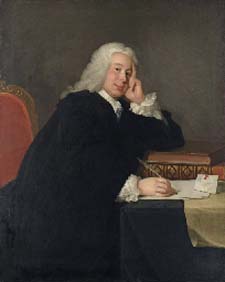George Hardinge
Judge, Author & Politician
1743 - 1816

George Hardinge, Welsh judge (Justice of the Courts of Brecon), author and politician, is recorded as the owner of Ragman's Castle on Twickenham Riverside from about 1780 and perhaps until his death at Presteigne in Radnorshire in 1816. He was possibly attracted to Twickenham by his friendship with Horace Walpole and Richard Owen Cambridge.
He was born at Canbury Manor, Kingston-upon-Thames, where his father, Nicholas (1699-1758) lived, the son of Gideon (1669-1712), Vicar of Kingston from 1692. Gideon was the son of Sir Robert Hardinge of Kings Newton, Melbourne, Derbyshire.

Nicholas, Latin poet and politician, was Clerk to the House of Commons from 1732 until 1748 when he sold the office to Jeremiah Dyson (1722-77) for £6,000. Hardinge probably came into contact with his son, also Jeremiah, through the latter's employment as Assistant Clerk to the Commons, because in 1808 he leased his Twickenham property to him.
The oldest surviving of twelve sons and daughters, George was sent first to Kingston Grammar School, then Eton. While there, at the age of 15 his father died and he inherited the Canbury estate. He went on to Trinity College Cambridge before being admitted to the Middle Temple, being called to the Bar in 1769.
In 1766 he was appointed secretary to Chancellor Lord Camden, his uncle. In 1782 he was appointed solicitor-general and in 1794 attorney-general to Queen Charlotte. Between 1784 and 1801 he served as MP for Old Sarum through the influence of William Pitt.
In 1777 he married Lucy Long (d1820), daughter of Richard Long of Hinxton, Cambridgeshire. It was, apparently, an unsuccessful marriage and there were no children of the union. In his will he left her 100 guineas or a ring of the same value, in addition to the settlement of £900 a year. Curiously, he owned a portrait of her by Reynolds, in the possession of the artist Richard Cosway, which he bequeathed to Lady Selsea (sic), wife of Sir James Peachey, 1st Lord Selsey. Being without children he adopted a nephew, described in his will as “my heroic nephew the late Captain George Hardinge”. This was the son of his brother Henry, rector of Stanhope in County Durham. Hardinge had been killed in a naval action off Ceylon in 1808 and a statue in his honour was erected in St Paul's Cathedral. The will makes a number of references to him, featuring memorabilia including maquettes and sketches of the statue, and swords.
Hardinge's will made his nephew Charles, vicar of Tonbridge, his principal heir and executor. It only mentions property in general terms, in Kingston, Richmond, Kew, Ham and Petersham. There is no mention of Ragman's Castle, which must already have been sold. He may have returned to live at Canbury Manor: Walpole and Cambridge no longer his neighbours in Twickenham. However, by the time that he made his will, in 1815, he was living at Milbourne House in Esher.
Much of his will consisted of repetitively tortuous and inalienable bequests to family and friends, of pictures and engravings from his collection.

The Family Estates
Kings Newton Hall was the Hardinge property in Melbourne, Derbyshire. Built in the 17th century, destroyed by fire in 1859 and rebuilt in replica in 1910, it stands today. Reputedly, the Hardinge family lived at Kings Newton from the 11th century. Sir Robert Hardinge (1621-1679) was a staunch Royalist, son of Nicholas and Isabel. The earliest Hardinge recorded there was another Nicholas, born in 1490.
At Kingston, Canbury Manor, the Rectory and the advowson were connected. In 1641 the advowson came into the hands of William Murray, created Earl of Dysart in 1643. While the Ramsay family also acquired rights it was the Countess of Dysart who presented Thomas Willis to the Living in 1671. In that year Nicholas Hardinge acquired the Rights and, in 1692, following the death of Thomas Willis, he presented his cousin Gideon, father of Nicholas. In 1786 George sold the the Advowson to Kings College, Cambridge. They remain the patrons of the living, but the manor and rectory, which disappeared early in the 19th century have, today, no ascertainable substance.
further reading:
The Oxford Dictionary of National Biography
A C B Urwin, The Vicars of Twickenham 1640-1661, Borough of Twickenham Local History Society Paper no18, 1970 (for Thomas Willis)



